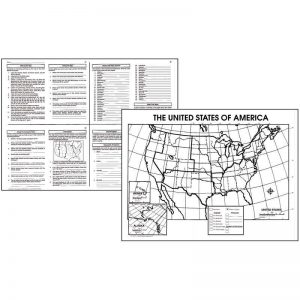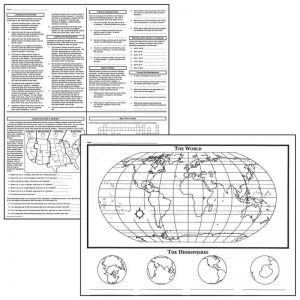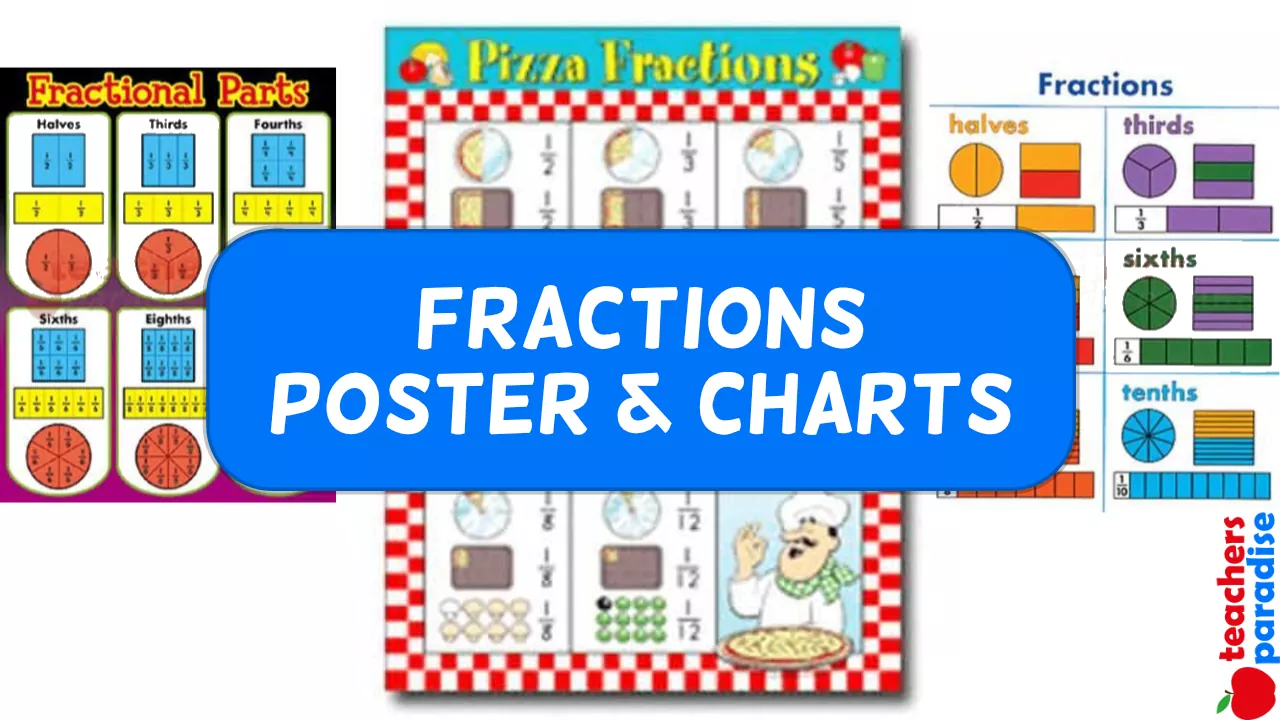Shakespeare Reproducible Book
This book teaches students about the life and works of the great English playwright William Shakespeare. The first six pages present background information that helps students see the influence of the Elizabethan Age on Shakespeare’s writing. Pages 7 through 21 cover some of Shakespeare’s most popular works. The wide variety of activities included on these pages encourages students to focus on Shakespeare’s techniques in developing plots, characters, and themes as well as his use of language. The remaining pages provide exercises that tie together common themes and techniques used in Shakespeare’s works. These pages also check students’ knowledge about the well-known bard.
WORKSHEET & Sample PDF Activity
Sample PDF Activity
England and Elizabeth
Queen Elizabeth I ruled England from 1558 to 1603. During her forty-five year reign, England gained political power, national pride, and many cultural achievements. Because Elizabeth was so influential in leading this English renaissance, the last half of the sixteenth century in England is known as the Elizabethan Period. The Elizabethan period spanned most of William Shakespeare’s life.
Elizabeth came to the throne after the deaths of her half brother Edward and her half sister Mary, whose rule had left England in a state of political and religious turmoil. The intelligent and politically shrewd Elizabeth worked with Parliament to ease the divisions within the country. By remaining single, she sought to avoid the political entanglements that marriage to a foreigner could bring. She encouraged exploration, which led to Englishman Sir Francis Drake’s successful voyage around the world from 1577 to 1580. Also during Elizabeth’s rule, England became a world power with the triumphant defeat of the Spanish Armada in 1588. For the next three centuries, England would dominate world trade and colonization.
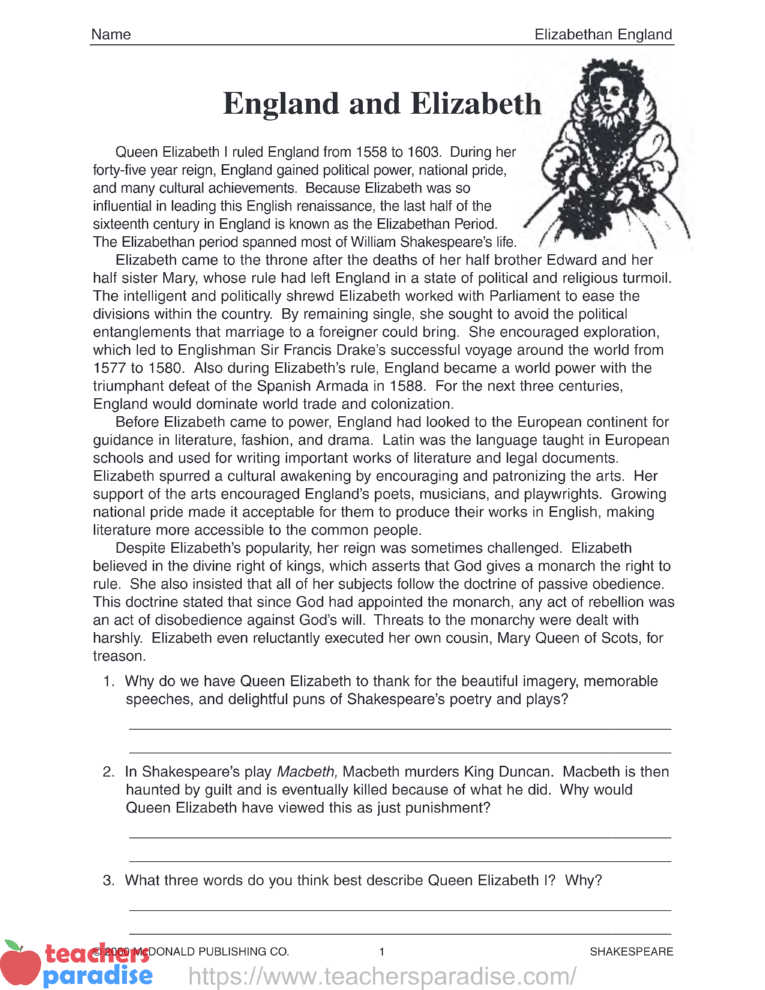
Before Elizabeth came to power, England had looked to the European continent for guidance in literature, fashion, and drama. Latin was the language taught in European schools and used for writing important works of literature and legal documents. Elizabeth spurred a cultural awakening by encouraging and patronizing the arts. Her support of the arts encouraged England’s poets, musicians, and playwrights. Growing national pride made it acceptable for them to produce their works in English, making literature more accessible to the common people.
Despite Elizabeth’s popularity, her reign was sometimes challenged. Elizabeth believed in the divine right of kings, which asserts that God gives a monarch the right to rule. She also insisted that all of her subjects follow the doctrine of passive obedience. This doctrine stated that since God had appointed the monarch, any act of rebellion was an act of disobedience against God’s will. Threats to the monarchy were dealt with harshly. Elizabeth even reluctantly executed her own cousin, Mary Queen of Scots, for treason.
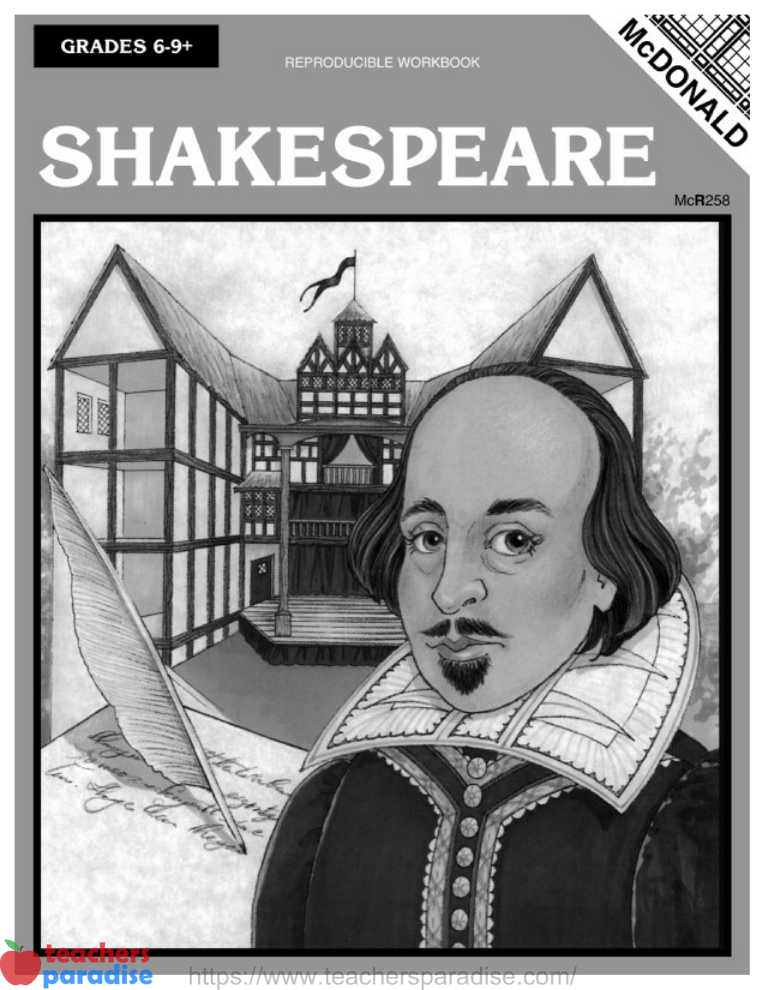
- Why do we have Queen Elizabeth to thank for the beautiful imagery, memorable speeches, and delightful puns of Shakespeare’s poetry and plays?
- In Shakespeare’s play Macbeth, Macbeth murders King Duncan. Macbeth is then haunted by guilt and is eventually killed because of what he did. Why would Queen Elizabeth have viewed this as just punishment?
- What three words do you think best describe Queen Elizabeth I? Why?
Young Shakespeare – Shakespeare’s Life: 1564-1592
William Shakespeare was born in 1564 in England in the small town of Stratford-upon-Avon. He was the oldest son of Mary and John Shakespeare. William’s mother was from a prominent family. His father was a glove maker who at one time was the high bailiff, or mayor, of Stratford. Records of Stratford’s Holy Trinity Church show that William was baptized there on April 26, and since infants were usually baptized three days after birth, April 23 is recognized as his birthday.
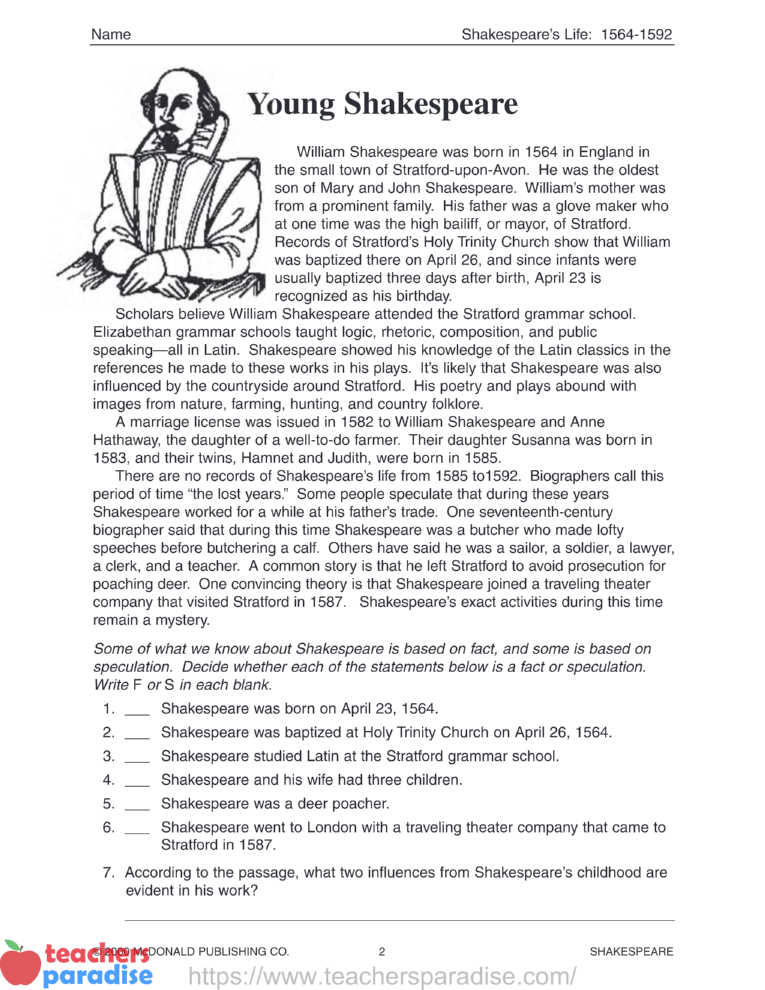
Scholars believe William Shakespeare attended the Stratford grammar school. Elizabethan grammar schools taught logic, rhetoric, composition, and public speaking—all in Latin. Shakespeare showed his knowledge of the Latin classics in the references he made to these works in his plays. It’s likely that Shakespeare was also influenced by the countryside around Stratford. His poetry and plays abound with images from nature, farming, hunting, and country folklore.
A marriage license was issued in 1582 to William Shakespeare and Anne Hathaway, the daughter of a well-to-do farmer. Their daughter Susanna was born in 1583, and their twins, Hamnet and Judith, were born in 1585.
There are no records of Shakespeare’s life from 1585 to1592. Biographers call this period of time “the lost years.” Some people speculate that during these years Shakespeare worked for a while at his father’s trade. One seventeenth-century biographer said that during this time Shakespeare was a butcher who made lofty speeches before butchering a calf. Others have said he was a sailor, a soldier, a lawyer, a clerk, and a teacher. A common story is that he left Stratford to avoid prosecution for poaching deer. One convincing theory is that Shakespeare joined a traveling theater company that visited Stratford in 1587. Shakespeare’s exact activities during this time remain a mystery.
Some of what we know about Shakespeare is based on fact, and some is based on speculation. Decide whether each of the statements below is a fact or speculation. Write F or S in each blank.
- _ Shakespeare was born on April 23, 1564.
- _ Shakespeare was baptized at Holy Trinity Church on April 26, 1564.
- _ Shakespeare studied Latin at the Stratford grammar school.
- _ Shakespeare and his wife had three children.
- _ Shakespeare was a deer poacher.
- _ Shakespeare went to London with a traveling theater company that came to Stratford in 1587.
- According to the passage, what two influences from Shakespeare’s childhood are evident in his work?
Table of Contents
1 England and Elizabeth Elizabethan England
2 Young Shakespeare Shakespeare’s Life: 1564-1592
3 Shakespeare as an Adult Shakespeare’s Life: 1592-1616
4 Shakespeare’s Stage The Globe Theatre
5 No Females Allowed! Shakespeare’s Actors
6 Royal Fans Shakespeare’s Patrons
7 Important Drama Terms Vocabulary Review
8 Future Beaus or Foes? A Midsummer Night’s Dream
9 Explain Yourself, Romeo! Romeo and Juliet
10 Who’s to Blame? Romeo and Juliet
11 To Crown or to Kill? Julius Caesar
12 “Lend Me Your Ears” Julius Caesar
13 To Avenge or Not to Avenge? Hamlet
14 Appearance vs. Reality Hamlet
15 A Model Tragedy Othello
16 A Play to Please a King Macbeth
17 Weighing Choices Macbeth
18 Shakespeare’s Farewell The Tempest
19 Important Poetry Terms Vocabulary Review
20 Shakespearean Sonnets Sonnet 18
21 A Study of a Sonnet Sonnet 29
22 Shakespeare: Borrower and Lender Shakespeare Sources and Spin-offs
23 Shakespeare’s Songs Music of the Shakespearean Stage
24 Speaking of Shakespeare Everyday Language from Shakespeare
25 Name-Calling—Shakespeare Style Shakespearean Insults
26 Shakespeare’s Spirits Fantastic Shakespearean Characters
27 William’s Words? Famous Shakespearean Quotes
28 Truth or Tale? Review

